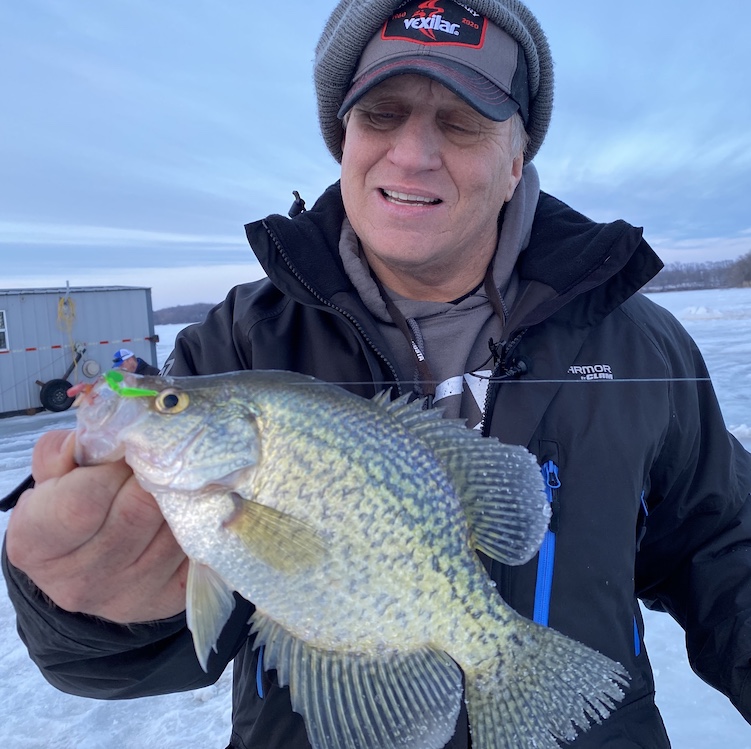On the Edge for Fishing Success!

On The Edge for Fishing Success!
By Mike Frisch
As I sat in my tree stand (located on the edge of a thick deer bedding area) tonight, I started thinking about the importance of cover edges to both fishing and hunting success. The edge my stand sits on is where heavy cover opens up to a tall timbered, more open area that borders good food sources. The deer bed in the thick “stuff” and use the taller trees as a travel corridor to agricultural fields. This spot has a history of producing good shot opportunities.
When I trade my bow for a shotgun and chase pheasants, another edge, this time where a harvested bean field butts up to heavy CRP grass, is another hotspot. Pheasants use the heavy grass for cover and roosting and the bean field for food. A walk down the edge just into the grass during the last hour of legal shooting often yields good results.
In both these cases the cover is important for protection and as sort of a sanctuary, while the food is important for obvious reasons. Often fishing success, regardless of winter or summer, is also found along edges.
One of the most obvious “fishing edges” is the inside or outside edge of a band of weeds that rims a lake’s perimeter. In many lakes, a relatively clean sand flat eventually gives way to weeds on softer bottom. Those weeds grow out to deeper water where they eventually taper due to lack of sunlight. This classic “deep weedline” is where walleye, panfish, and bass anglers often fish. Active fish of various species cruise these edges looking for schools of minnows, then darting into the thick weed cover when bigger predators appear. The fish also head to the weeds when they’re inactive.
The deep weedline is a favorite during summer, but also can be a hotspot for ice fishing too, particularily early in the winter. Sometimes green, living weeds remain at first ice and areas where that happens can be hotspots as oxygen, baitfish, and bigger fish will load up there. As winter progresses and snow cover increases, the weeds may die back and the area loses its appeal.
Weed edges provide cover and food for fish, but other edges will hold fish as well. For instance, one of my all-time best winter walleye spots is a small stretch of rocks along the drop-off edge of a sand flat. The outside, or deeper edge, of the rocky stretch often holds walleyes during the early ice season. Several of my favorite “transition areas” like this one were found when scouting for fish during open water. These areas are noted and filed away for winter because they can be outstanding ice fishing spots too!
Weed lines and bottom transitions are often fish magnets, but the edges of underwater structure like sharp dropping flats and sunken humps will hold fish as well. These depth change edges provide fish deeper water to languish in during periods of inactivity, often during mid-day, with quick access to shallower water that often holds bait, particularly during low light periods.
Drop-off edges like this can be great spots to intercept gamefish at last light as they move up to feed. Sometimes a “straight” drop-off edge is productive, though I like to target any irregularities like points or turns the drop-off forms as these areas are often the “spot on the spot.”
Regardless what type of edge I’m fishing, relying on my winter sonar unit is vital. A properly adjusted quality sonar like those made by Vexilar will obviously help me find depth change edges. However, sonar will also clearly show weeds (helping to identify weed lines) and can show bottom transitions too. Plus, of course, the ability to “see” fish relating to any edge is another big advantage that makes winter sonar so important!
Finding fishing success starts with finding fish-holding structure. In many lakes that involves searching along some form of edge. Whether it be weeds, bottom changes, or drop-offs spending time searching “on the edge” is a great way to find fish and ultimately put more on the ice during your trips this winter.
As always, remember to include a youngster in your outdoors adventures!
Mike Frisch hosts the popular Fishing the Midwest TV series. Visit www.fishingthemidwest.com or follow Fishing the Midwest on Facebook for more "fishy" stuff.

